Why the Azores is the best place to see sperm whales up close
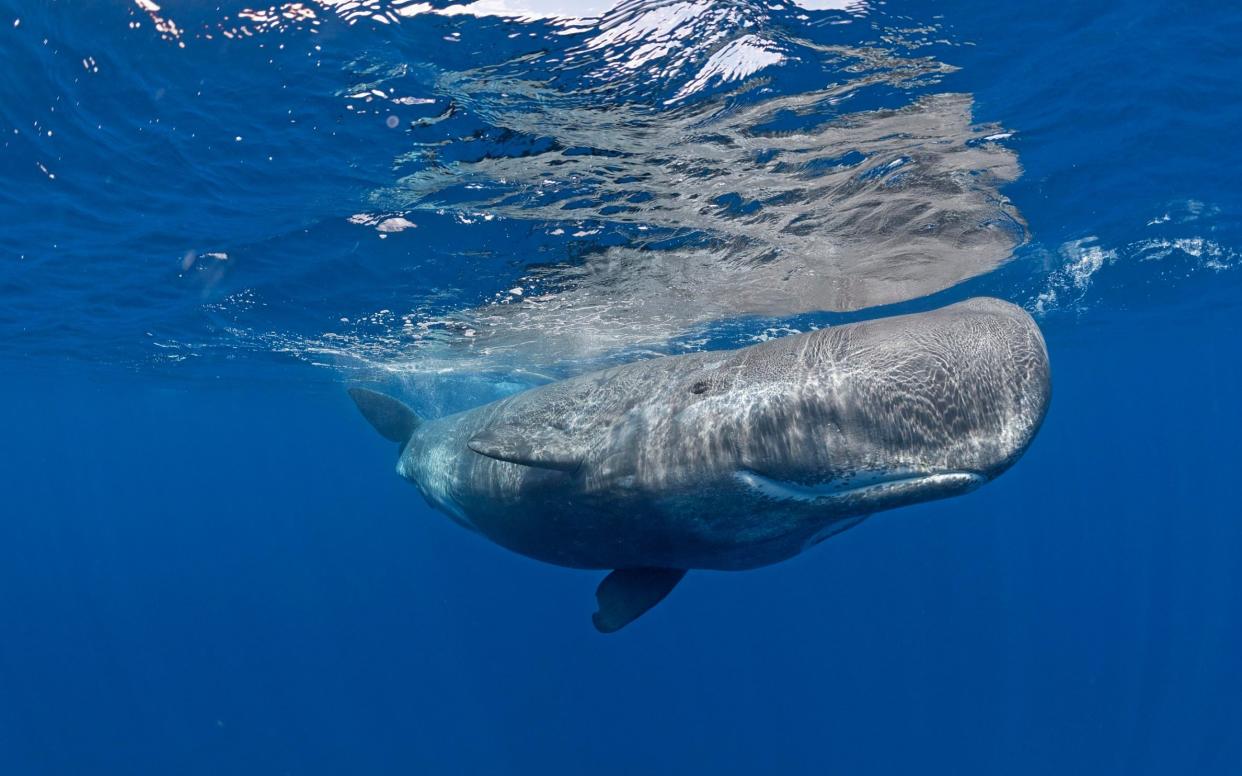
There is something about watching whales that transports us to a calmer, better place: their stealth and streamlined grace, perhaps, or that they are gentle, despite their size. Or that they seem to possess superpowers unimagined, barrelling torpedo-like to the deepest ocean floors as they communicate wistful songs, perhaps of past injustices wrought upon their kind by the creatures above water with cruel harpoons.
I was reacquainted with them earlier this year in the Azores, now a UK green-list destination, during a week-long whale-watching trip featuring sea excursions across the Portuguese archipelago’s nine islands. My last encounter had been in Antarctica in March 2020, where I witnessed humpbacks fattening up for long migrations to the mid-latitudes to bear calves. I envied their freedom as we parted ways for very different worlds.
Several months on, whales were once again congregating in great numbers during summer in the Azores. A deep, fertile continental shelf attracts up to 28 species – a quarter of all cetaceans – including blue whales, which had transited during springtime, when we had been prohibited from travel.
No matter. I had flown to the largest island, Sao Miguel, hoping to see the most iconic Azorean species, perhaps the very archetype of its kind: the sperm whale. This is every child’s image of a whale; the nemesis of Ahab depicted in Herman Melville’s Moby-Dick is an example of a mammal whose prized spermaceti-oil saw them hunted remorselessly across the Atlantic from the 1700s. The local name is cachalot or “big head”, referring to a cranial cavity hosting the animal kingdom’s largest brain. And it was those heads, bobbing like neoprene buoys, that alerted our spotter, Lorenzo Fiori, 20 minutes after we departed the town of Vila Franco do Campo on Sao Miguel.
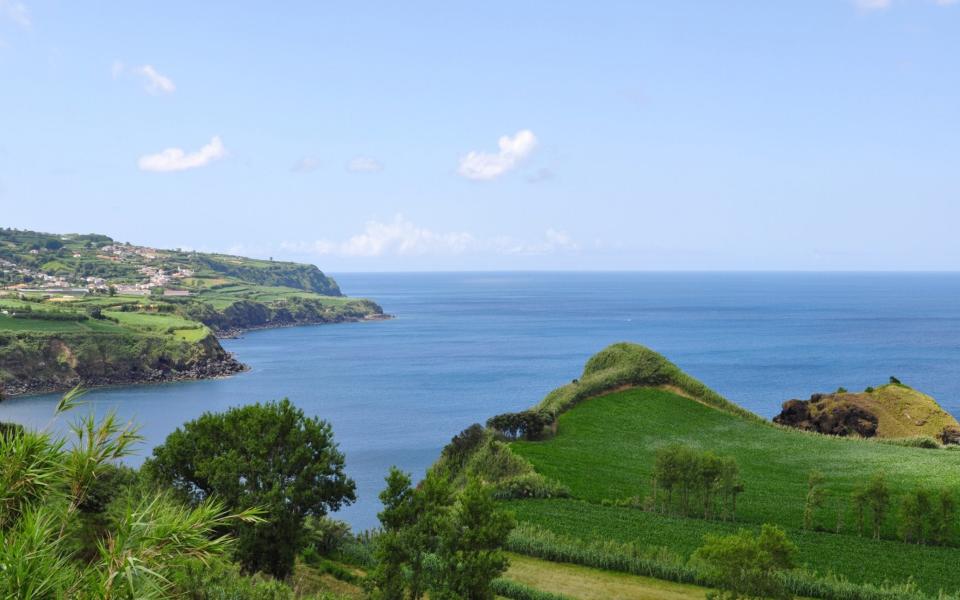
“Cachalot!” he hollered, as our Zodiac inflatable sped along on a mirror-glass morning into a boundary-less infinity of azure sea and sky.
Their heads account for one-third of colossal bodies that may reach 55ft long, Fiori explained as he cut the engine to avoid spooking them during a deep dive (these toothed whales may spend up to an hour underwater, hunting giant squid). Stealthily, we sidled alongside four sperm whales snugly aligned, upright, side-by-side. “This is a juvenile bachelor group,” said Fiori.
In silken sea conditions they floated in transcendental stillness. They were half-asleep, vertically. An underwater camera revealed bodies tapering away from bulbous lopsided heads with tiny pectoral fins rendering the appearance of gargantuan tadpoles. A lump on the left side of their head is the blowhole, while to the right are acoustic lips linked to a cranial organ producing the spermaceti: a waxy oil once prized for clean-burning candles and lubricants. One whale could yield up to three tonnes of the stuff.
Scientists are still unsure of the biological purpose of spermaceti. One theory is that it is a temperature-driven buoyancy aid (heat makes it viscous and lowers its density, allowing the whale to float; water taken in through the blowhole cools the substance into a denser solid and lets the whale sink again. A more recent belief is that the substance directs the clicks whales use to echolocate and communicate underwater.
And these boys were chatty. Fiori placed a hydrophone into the sea to register an unfathomable barrage of staccato clicking, like Kalahari bushmen.
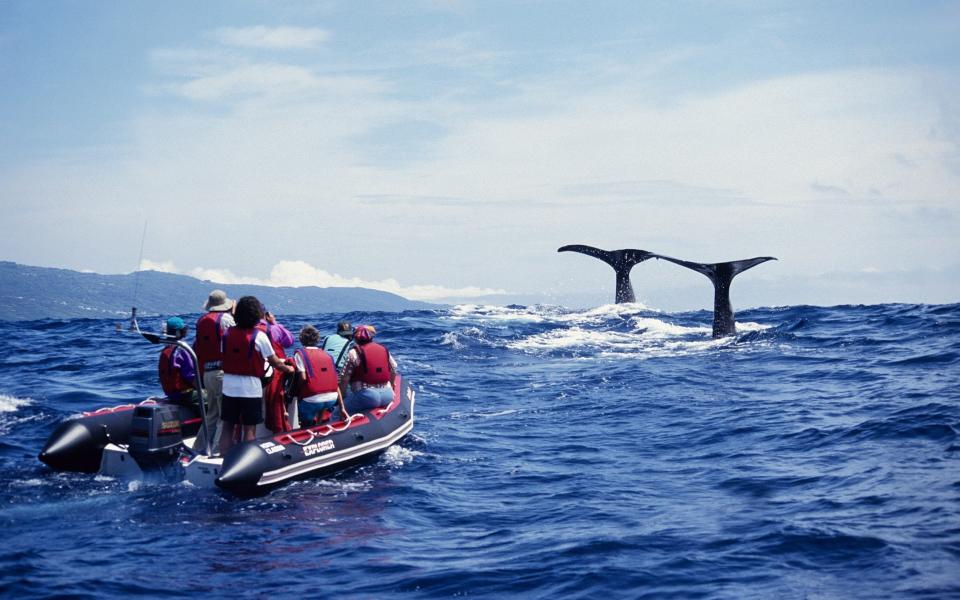
Sadly, the imperturbability of the sperm whale was its downfall during the widescale slaughter enacted by whalers, particularly those operating out of New Bedford, Massachusetts, many of which were crewed by Azorean emigres. Sperm whales were never Melville’s monstrous leviathans, with “an infernal aforethought of ferocity”.
“When a fellow whale was in trouble they would come to help and be killed themselves,” Fiori explained.
I witnessed these close social bonds manifest themselves again next morning when I returned to sea from Ponta Delgada wharf, a stone’s throw from my accommodation in the city, Hotel do Colegio: a grandiose 19th-century former music conservancy with a neogothic interior hewn from black volcanic basalt. This time, a small calf shadowed its mother’s shallow dives.
“When the mother dives deep for food, the suckling calf may be left on the surface, but they communicate throughout by soundwaves that can travel many miles,” said my guide for the morning, Ana Castanheira, adding: “It takes three years for the calf to learn the ‘codas’ of its pod.”
I wondered if the young calves were bamboozled by other languages of the sea, because on our way back to shore dozens of bottlenose dolphins raced our boat, surfing its wake, their squeaks and clicks audible above water, their unencumbered energy joyous and uplifting.
On land, the legacy of whaling permeates the islands. Around Sao Miguel’s coastline are historic lookout huts called vigia, where experienced spotters could sight whales 25 miles out to sea. The spotters lit rockets to inform whalers in seaside villages, who for the most part were also farmers. Given the volcanic terrain and unpredictability of seismic activity in the area, it is perhaps unsurprising that the men took to whaling to supplement their incomes.
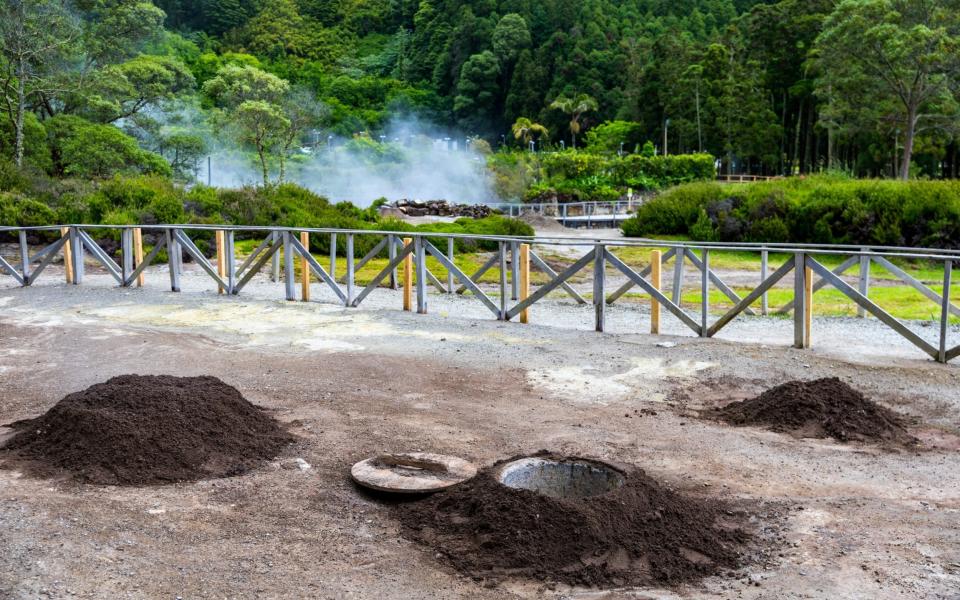
Amid this harsh landscape, there is an idiosyncratic beauty throughout the archipelago. On Sao Miguel, within a five minute drive you can find yourself moving from black sand beaches, where banana palms grow, through emerald pasture and hydrangea hedgerows, to chapels built high on volcanic cliffs that eulogise the miracles of Mary. The village of Furnas, meanwhile, is a bubbling crater-scape where an island speciality called cozido – a hearty stew of pork, beef and chicken – simmers for five hours underground in superheated geothermal steam.
The epicentre, both of vulcanicity and whaling history, lies a 40-minute flight away westwards on Pico, in the central Azores island group. The island is dominated by Mount Pico, a 7,713ft stratovolcano – Portugal’s highest peak – that last erupted in 1720. Over time, tumbling caustic lava-flows instilled the fear of God in disbelieving islanders – though it never terrified them enough to stop their remarkable wine production on the volcano’s roughhouse flanks. A chequerboard of currais resemble an uncovered archaeological ruin, yet these lava-stone enclosures shield vines from Atlantic winds and yield dry, minerally wines that are the finest in the Azores.
On Pico your ancestors were either whalers or winemakers. “My grandfather and father were whalers. But life was hard here, so they migrated to Canada in 1974,” said my taxi driver, Carlos Costa. His descendants worked in Pico’s processing factories, now museums, where the magnificent mammals were reduced to barrels of spermaceti and fertiliser meal rendered from bones, blubber and blood. Occasionally the whalers struck pay gold by finding ambergris – secretions coating indigestible squid beaks in the whales’ intestines – which was highly prized in the world of perfumery.

The best exposition of whaling is to be found in the Museu dos Baleeiros – Whalers’ Museum – in the pretty port of Lajes, where Hotel Whale’come (yes, really) would likely amuse an 18th-century English sailor. Yet an affecting and visceral film shown in the museum, made in 1970 and chronicling the barefoot whalers of Lajes, wiped the smirk off my face. When alerted to whales offshore, the men hurried from their fields to launch small wooden sailboats to sea. The film shows the gory, hazardous horror of it all. Other exhibits include scrimshaw art – engraved whalebones and teeth – as delicate as it is macabre.
These baleeiros never got rich by whaling. On Pico, only 62 sperm whales were caught between 1886 and 1890, split between 37 whaleboats. “They had little choice, they were poor,” Cecilia Jorge, my guide, told me. “My mother says if she found a bottle washed ashore in her childhood it was treated like a find of treasure. But I don’t understand why the whales never fought back. One swish of their tail and the small boats were sunk. I think the cachalots didn’t realise how big they were.” (That wasn’t the case in 1820 when Massachusetts whaler Essex was sunk by a bull whale that rammed her bow: the event that inspired Moby-Dick.)
The last whale killed in the Azores met its end off the shore of Pico in 1987, defying the International Whaling Commission moratorium of a few years earlier. Nowadays, the old baleeiros would find more gainful employment in guiding: Azorean whale-watching was born on Pico around 1991.
My final voyage to sea is from neighbouring Faial Island, a 30-minute ferry ride away. The Piconese mock their neighbours, suggesting the best thing about Faial is the view back to Pico’s volcano. There’s a crumb of truth in this: upon reaching Horta, Faial’s main port, the volcano reappears from a labyrinth of circular clouds. Yet Faial has its own spectacular volcanic narrative too, notably that of Capelinhos, which produced the Azores’ last eruption in 1957. The island was also a significant exporter of spermaceti: 5,000 barrels were shipped from Horta to the US in 1950 alone.
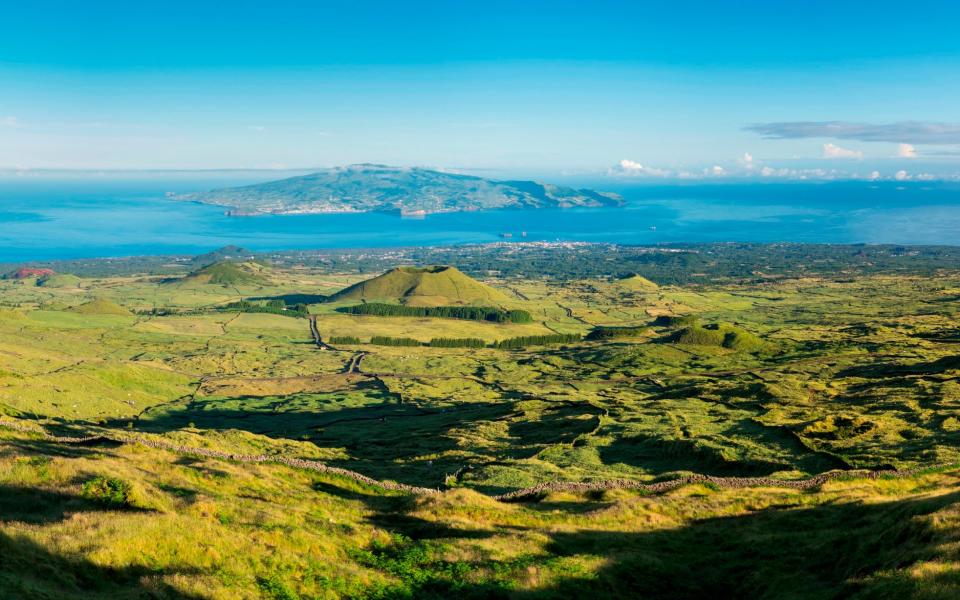
We encountered a matriarchal pod after an hour in choppy sea and what a gravity-defying spectacle it was: in the distance a whale breeched, all 30 tonnes of it, momentarily suspended in mid-air. “It’s still uncertain why they do this,” said American marine biologist Lisa Steiner, of Whale Watch Azores. “Maybe the young are toning their muscles for long journeys ahead. Or perhaps just having fun.”
Steiner’s database includes 3,000 individual sightings, all recorded by markings revealed when the cachalots aerially extend their muscular tail-fluke vertically before diving deep. Her memory seems photographic, so much so that she yelped excitedly at seeing one tail-dive: “That’s 19. I recorded her back in 1987 and I’ve seen her many times over the years. She’s like an old friend!”
She told me our sighting represented the longest duration – 34 years – that any whale has been continually observed. It felt karmic: the sort of magical reality only whales can deliver. Number 19 was first seen the same year that the last Azorean whale was killed. All this female has ever known is a life unhindered by those creatures bearing harpoons – which is something to be cherished.
How to do it
• Mark Stratton travelled with Sunvil (020 8568 4499; sunvil.co.uk) which offers a seven-night whale-watching holiday from £1,288 per person including B&B, flights and four whale-watching excursions.
• Ryanair (ryanair.com) offers direct flights from Stansted to Ponta Delgada
• Hotel do Colegio (0035 1296 306600; hoteldocolegio.pt) in Ponta Delgada has double rooms from €134. Hotel Aldeia da Fonte (0035 1292 679500; aldeiadafonte.com) on Pico has doubles from €110.
• Whale-watching operators include Terra Azul on Sao Miguel (azoreswhalewatch.com), Picos de Aventura on Sao Miguel (picosdeaventura.com) and Azores Experiences on Faial (azoresexperiences.com)
• For more information, visit whalewatchazores.com


